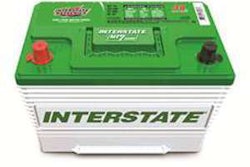
Winter weather takes a lot of blame for battery failures, but often the damage caused by hot-weather driving is the primary culprit.
“Generally, more damage is done to the battery during the summer months,” says Patrick McLaughlin, Exide Technologies Product Manager. “However, it may not be noticeable until the colder months when the battery needs to work harder.”
Lead acid batteries – a common battery chemistry in trucking fleets – have a higher discharge rate in elevated temperatures and high-heat climates can accelerate the evaporation of electrolytes, shortening service life.
Fleets running trucks with APUs and added amenities are migrating to absorbed glass mat (AMG) batteries, which feature both high cranking and deep-cycle power. They are also not susceptible to electrolyte loss.
“The electrolyte is absorbed by a very fine fiberglass mat and the unit is sealed, eliminating the damage that can be caused from loss of electrolyte,” says Alan Kohler, transportation and specialty marketing manager for EnerSys. “Sealed batteries don’t openly vent, therefore they do not dry out.”
“If your cab is decked out with extra plug-ins and appliances, or if you are running AC when parked in a hot climate, the AGM is probably the best choice for you,” adds Interstate BatteriesDirector of Quality, Supply Chain Management Bob Gruenstern.
The leading cause of failure in cranking batteries is the degradation of the positive-grid current collectors inside each cell. Lead acid batteries operate using an oxidation-reduction reaction, which Gruenstern says oxidizes the positive grids as the battery charges.
“Temperature is an accelerator to this corrosion process,” he says. “The more time the battery spends in a hot environment, the faster this corrosion takes place.”
Despite that a truck’s batteries operate nearly every major component on the vehicle, Gruenstern says barely half of all fleets – just 54 percent – admit to testing them as part of routine service.
“Optimally, you should inspect and test batteries regularly with every scheduled preventative maintenance inspection, and charge the batteries if they are low on charge,” he says. “Do not rely on the alternator to do the charging. Over time this can cause alternator stress, resulting in a premature alternator failure.”
The first step of a battery check, Gruenstern says, is to check the battery connections and clean the posts. In some cases, battery acid level can be checked and adjusted if necessary with distilled water. Also, inspect the hardware that secures the battery to the truck. Vibration, Gruenstern says, can damage a battery if the hold-down hardware is loose or missing.
Kohler says a basic quick check of how the battery is doing starts with a simple voltage check. McLaughlin says for most 12-volt batteries, trucks require a 75-percent state of charge – 12.4 volts – to turn over the engine. Kohler adds any 12-volt AGM battery that is fully charged should measure about 12.8 volts.
“Extreme variations in battery voltage can mean trouble,” he says.
A true test of a battery’s health requires a battery tester. Gruenstern says a good battery tester will check for other hidden signs of trouble beyond just checking the open circuit voltage (OCV) of the battery. He suggests choosing a battery tester that checks OCV to verify the battery is being properly charged and also gives a reading of starting capability.
“It is best to check each battery individually, not in a series,” Kohler adds. “This will indicate if one specific battery is having more of a problem than another in the system.”
For “hard starts” or shorter run with hotel loads, Paccar Parts Senior Product Director of Power Generation Jackie LeFort says it may be time to test the battery pack. He says when the battery pack is tested look for the following factors: State of charge of the battery pack; when fully charged, the battery level is 12.65 volts for flooded batteries and 12.75 volts for absorbed glass mat or AGM; hold downs and battery connection are securely fastened; if the battery pack is found to be in a discharged state, the batteries should be fully recharged and tested with either a load or conductance tester.
Most starting batteries in trucks leaving the factory feature 650 or 700 cold cranking amps (CCA) unless spec’d otherwise for a specific application. For trucks that spend much of their service life running in a hot environment, McLaughlin suggests looking into batteries that feature lower CCA.
“Flooded batteries with a lower CCA – 600 to 750 – usually have thicker or less plates that can hold a charge for longer periods,” he says. “With less plates than a higher CCA battery, the additional acid in the case allows for better cooling properties.”
Gruenstern says a common misperception is that more CCA is always better when, in reality, it doesn’t pay to select the highest CCA rated battery unless the truck manufacturer specifies it, or if the truck operates in very cold climates.
“A lower CCA rated battery can perform better in hot climes because there is greater electrolyte volume,” he says.












